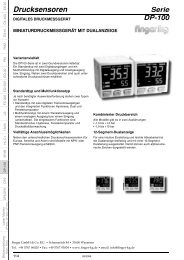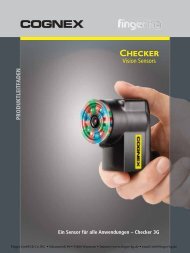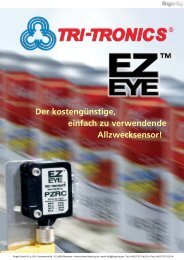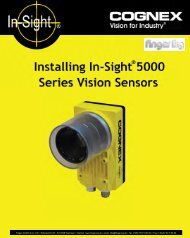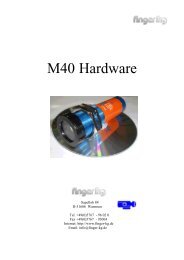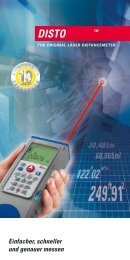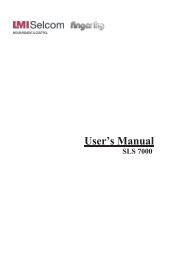TRIANGULATION LASER SENSORS, LDS603 Series Rev. G (26.06 ...
TRIANGULATION LASER SENSORS, LDS603 Series Rev. G (26.06 ...
TRIANGULATION LASER SENSORS, LDS603 Series Rev. G (26.06 ...
You also want an ePaper? Increase the reach of your titles
YUMPU automatically turns print PDFs into web optimized ePapers that Google loves.
<strong>TRIANGULATION</strong> <strong>LASER</strong> <strong>SENSORS</strong>, <strong>LDS603</strong> <strong>Series</strong><br />
All messages with a message burst contain 1 in the most significant digit. Data in a message are<br />
transferred in tetrads. When byte is transmitted, lower tetrad goes first, and then follows higher tetrad.<br />
When multi-byte values are transferred, the transmission begins with lower byte.<br />
When ‘answer’ is transmitted, the message contains three additional bits of cyclic binary batch<br />
counter (CNT). Bit values in the batch counter are identical for all sendings of one batch. The value<br />
of batch counter is incremented by the sending of each burst and is used for formation (assembly) of<br />
batches or bursts as well as for control of batch losses in receiving data streams. The following is<br />
the format of two ‘answer’ data bursts for transmission of byte DAT(7:0):<br />
Page 6/22<br />
Dt0(7:0);Dt1(7:0) = 1,CNT(2:0),DAT(3:0);1,CNT(2:0),DAT(7:4).<br />
8.8. Result transfer. An answer is formed as in 8.7.<br />
8.9. Types of inquiries.<br />
Inquiry<br />
Description Message<br />
Answer<br />
code<br />
(size in bytes)<br />
(size in bytes)<br />
01h Device identification — –device type (1)<br />
–modification (1)<br />
–serial number (2)<br />
–base distance (2)<br />
–range (2)<br />
02h Reading of parameter - code of parameter (1) - value of parameter (1)<br />
03h Writing of parameter - code of parameter (1)<br />
—<br />
- value of parameter (1)<br />
04h Storing current parameters to<br />
FLASH-memory<br />
- constant AAh (1) - constant AAh (1)<br />
04h Recovery of parameter default<br />
values in FLASH-memory<br />
- constant 69h (1) - constant 69h (1)<br />
05h Latching of current result — —<br />
06h Inquiring of result — - result (2)<br />
07h Inquiring of a stream of results — - stream of results (2)<br />
08h Stop data streaming — —<br />
8.10. List of parameters<br />
Code of<br />
parame-<br />
ter<br />
Name Values<br />
00h Sensor ON 1 — laser is ON, measurements are taken (default state);<br />
0 — laser is OFF, sensor in power save mode<br />
01h Analog output ON 1/0 — analog output is ON/OFF; if a sensor has no analog output, this bit<br />
02h Sampling and synchronization control<br />
<strong>Rev</strong>. G (<strong>26.06</strong>.2008)<br />
will remain in 0 despite all attempts of writing 1 into it.<br />
x,x,x,C,x,M,R,S – control byte which determines CAN interface regime,<br />
bit C, logical output regime, bit M, analog output regime, bit R, and<br />
sampling regime, bit S;<br />
bites x – do not use;<br />
bit C:<br />
0 – request mode of CAN interface (by default);<br />
1 – synchronization mode of CAN interface.<br />
bit M:<br />
0 – out of the range indication (by default):<br />
1 – mutual synchronization regime.<br />
bit R:<br />
0 – window regime (default);<br />
1 – full range.<br />
bit S:<br />
0 – time sampling (default)<br />
1 – trigger sampling<br />
Finger GmbH & Co. KG • Schamerloh 84 • 31606 Warmsen • Internet: www.finger-kg.de • email: info@finger-kg.de



